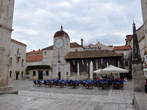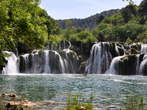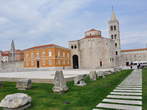Trogir is a Dalmatian city and port in Croatia, which belongs to the Split-Dalmatia County. It is located about 30 km from Split, in the Trogir Channel, at the end of the Kastel Bay. The historic core is included in the UNESCO World Heritage List.
The establishment of the women's Benedictine monastery of St. Nicholas in 1064 was very important for the town. Benedictine monastery and church of St. Nikolas are located in the southern part of Trogir. The establishment of the monastery is connected with the work of Bishop Ivan Trogir. The Benedictine monastery is important for church history in Croatia. The walled complex is a unique combination of various elements of town houses and towers, fortified walls and town gates, closed courtyards with harbors and a monastery church with a bell tower by Tripun Bokanic, a local craftsman from the island of Brac. In the courtyard, near the area where the Greek walls once stood, is the only Greek inscription in Trogir.
It is considered to be the first document of archival material of Trogir in stone. In the monastery collection there is a relief of the Greek God of Opportunity, Kairos, which was modeled after the bronze sculpture of Lysippus. In addition to fragments of a marble sarcophagus depicting the Achaean hero Achilles, parts of stone furniture from the 6th century and a pre-Romanesque statue from the 9th century are also exposed. In addition, the wooden cross by Paolo Veneziano from the 14th century, the altar of the Mother of God with child and saints, the Mother of God with saints, which is the work of Blaz Jurjev of Trogir, paintings of saints by the Venetian painter Nicolo Grassi from the 18th century, and many ritual objects, church vestments are also outstanding, silver objects and manuscripts.
The Benedictine monastery is a treasure trove of artistic and historical heritage in Croatia. In addition, major city attractions are the Cathedral of St. Lovrenc, the prince's palace, the Kamerlengo fortress, the large and small Cipiko palaces and the city lodge.






















 HR-CRO - Croatia
HR-CRO - Croatia
 from
from 






















